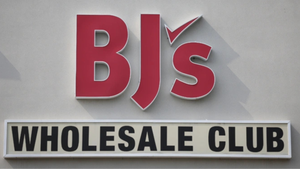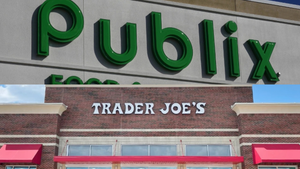SHUTTER BUGSHUTTER BUG
Retailers are wondering if enough Advanced Photo System cameras will be found under Christmas trees this year to jump-start film and processing sales of the new system.Eight months after a somewhat lackluster introduction, retailers still report disappointing sales. The initial launch was marred by a shortage of cameras, manufacturers admit, and a lack of consumer awareness, said retailers."Sales
December 30, 1996
PETER MALBIN
Retailers are wondering if enough Advanced Photo System cameras will be found under Christmas trees this year to jump-start film and processing sales of the new system.
Eight months after a somewhat lackluster introduction, retailers still report disappointing sales. The initial launch was marred by a shortage of cameras, manufacturers admit, and a lack of consumer awareness, said retailers.
"Sales have been fairly slow so far. We expect it to grow," said Dave Lynam, general merchandise and health and beauty care director at Harding's Friendly Markets, Plainwell, Mich. Harding's, with 34 stores in the Midwest, is selling both APS cameras and film. "It's a fairly new venture. We need market awareness -- that doesn't seem to be out there too much yet."
Eastman Kodak is hoping its high-profile television advertising campaign for its Advantix APS brand, featuring Dennis Rodman, will generate familiarity and the camera will be a prime gift item over Christmas. Between Thanksgiving and Christmas, Kodak expected its commercial, in which the outrageous basketball player rescues a cat from a tree in order to get an APS camera for Christmas, to make 1.2 billion impressions.
"We would expect sell-through of Advantix cameras over the holiday season will result in increased sales of Advantix film early in 1997," said John Dell, Kodak's U.S. trade marketing manager for the grocery channel, based in Atlanta.
Jonathan Rosenzweig, vice president of equity research, Salomon Bros., New York, agreed that APS products would begin generating more demand. "APS, which offers several benefits compared with traditional 35mm products, will continue to gain acceptance in the marketplace. Based upon dealer comments, the 1996 holiday selling season should generate some solid momentum," he said.
Supermarkets tend to sell more of film and photo-finishing than cameras, noted Tom Shay, spokesman for Fujifilm USA. "As we move into the holiday period, every indication we have is that sales have been very good." Fuji is also touting its APS products -- SmartFilm cartridges and Smart Endeavor cameras -- in a 30-second cable and network television spot entitled "Little Squares."
Dell said leading national grocery accounts are stocking APS cameras for the first time. These include Kroger Co., Cincinnati; Winn-Dixie Stores, Jacksonville, Fla.; Albertson's, Boise, Idaho; Dominick's Finer Foods, Northlake, Ill.; Randalls Food Markets, Houston; H.E.Butt Grocery Co., San Antonio; Vons Cos., Arcadia, Calif; and Cub Food Stores, Stillwater, Minn.
Albertson's is carrying both Kodak and Fuji APS products. "We have not noticed a strong customer demand," said Jenny Enochson, media relations coordinator.
"It has not been the most aggressive rollout," said Terry Green, corporate director of general merchandise for Cub. "I had some sales people who were realistic when they made the pitch. They said APS would account for between 4% and 6% of the market in 1996. I think that is pretty close."
Cameras are still in short supply, maintained Don Krizan, a film buyer for Grocer Supply, a wholesaler in Houston, which services a large variety of supermarkets. "I think they got the cart before the horse. If you go out and look, you will see very few cameras. People have no reason to buy the film if they can't buy the cameras. It's very slow so far. We might see some movement after Christmas," he said.
"We've sold almost seven times as many APS cameras as anticipated in the grocery channel," said Kodak's Dell. He would not say how many sales had been anticipated, but said less than 1% of all cameras presently in use are APS cameras.
Supermarkets are merchandising APS cameras, which retail between $70 and $130, behind the service counter. "We have a security problem. It's a small package and a high retail -- $75 for the cameras," said Lynam of Harding's. Cameras are also being sold self-service in some selected supermarkets that have dedicated stand-alone merchandisers. At Harding's, most of the film is on film racks in the general merchandise section on three-sided endcaps, Lynam said. "We are pricing it at the low end because we have some deep discounters in the area. Margins will be quite slim," said Lynam.
Ray's Food Place, Brookings, Ore., has remerchandised its film sections to merchandise Advantix at eye-level. "We have a sign furnished to us by Kodak that says 'New Advantix Film -- See Brochure.' We have a two-page flyer that explains how the technology works. It was installed by the brokers. Customers can help themselves to it," said Dan Van Zant, director of general merchandise.
APS technology was launched on April 22 at retail with new types of cameras and film. It was the collaborative brainchild of five companies: Kodak, Fuji, Minolta Co., Canon and Nikon Corp. Consumers have to pay 10% to 15% more for APS cameras, film and photo-processing than for traditional 35mm film. The main advantage is three different sizes of pictures to choose from: (4-by-6 inches, 4-by-7 inches and 4-by-10 inches). Consumers also like the fact APS cameras are easy to load and use, Rosenzweig of Salomon Bros. pointed out.
"If you have seen the pictures that come out they are neat. You get a panoramic view," said Cub Foods' Green.
Despite the panoramic pictures, some retailers and wholesalers surveyed by SN just prior to Christmas were not so enthusiastic about the sales performance of APS to date. While some chains are selling APS cameras and film, for the supermarkets that are still only selling APS film, sales have been slow.
"We are selling it, but not much of it. The movement is virtually nothing," said Kim Botkin, nonfood buyer, Gerland's Food Fair, Houston.
"What we are hearing is that it is moving very slowly in supermarkets," said Nels Leavey, president of Rainbow Distributors, a service merchandiser based in Timonium, Md., which services about 200 stores in Maryland, northern Virginia and Washington. "We are taking a wait-and-see approach until we see signs of movement or we get requests. It's not something we want to be a pioneer on. Margins on film are very poor in supermarkets -- they can be as low as 10% to 15%. We don't gamble in that category."
"It's not setting the world on fire, but it's building," said Grant Maclean, pharmacy/general merchandise buyer, Rosauers Supermarkets, Spokane, Wash.
Maclean said he hopes other retailers will sell a lot of APS cameras over Christmas, which would create a bigger demand for APS film in supermarkets.
"We've had it since the first of September. We are carrying just two SKUs. It's pretty slow right now," Van Zant said. "It's going to take a while before the public is educated.
"At this time, it is too early to measure the success or failure of APS," said Ted Fox, group executive of marketing information for the Photo Marketing Association, Jackson, Mich. "It's just now straightening [distribution] out."
Fox said manufacturers need to position APS clearly as something new and different. "There needs to be better point-of-purchase. The technology is evolutionary. It is positioned as a bridge to the digital world."
Fuji has developed packaging that is totally different from its other film products, Shay said. "The packaging was designed to make it look quite different so it wouldn't be accidentally picked up off the shelf. The APS film comes in 15, 25 and 40 exposures, which is different from what we're used to."
Film prices range from $3.50 to $5.50 per roll. Fuji's APS cameras range in price from $69.95 to $849.95. Shay said supermarkets are generally selling the cameras that cost under $100, as well as one-time-use cameras, which range between $10 and $20.
"When the system was launched in April, demand exceeded what we expected. Most of the shortages have been overcome," Shay said. He said Fuji and other manufacturers increased camera production in the second half of the year and camera availability has improved significantly.
"Most of the manufacturers had trouble passing quality control standards. That's why cameras were short in the early days," said Cub Foods' Green.
According to Kodak's Dell, supplies of higher-end cameras (above $150) continue to be restricted, but the supply difficulties of lower-end cameras (under $150) have "eased substantially" over the last couple of months. Kodak is still filling the pipeline with its one-time-use APS camera, which started to ship in August, he added. It has a suggested retail price of $15.95 and comes with a $2 instant-redeemable coupon.
One problem with APS was that before one-time-use cameras were on the market, there was a high cost of entry, he said. "one-time-use cameras will grow the business," Green said.
About the Author
You May Also Like




